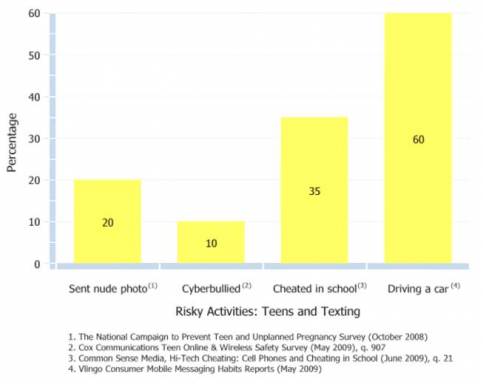How old was your child when they got their first cell phone? 14? 12? 8? If your pre-teen is begging you for a phone of their own and telling you that “all their friends” have one – they're probably not lying. The average age of kids who receive their first cell phone is falling like a brick. So how much does kids safety come into play?
A Pew Internet Forum survey in 2009 asked parents of cell phone owners the question, “How old was your child when s/he got her/his first phone?” The average age was 11-12. Of kids who owned cell phones, 46% got them in the 11-12 year age bracket.
Impact of Online Gaming on Teen Sleep and Kids Safety
Like most things teens might do to fill their time, online gaming has its pros and cons. Gaming improves hand-eye coordination, encourages problem solving, and can foster teamwork and social skills (in multi-player games.) On the other hand, too much of a good thing can be, well, bad and can affect teen kids safety. Several studies have followed the effects of gaming in teens, including the latest released by the American Psychiatric Association revealing a correlation between too little sleep and Internet gaming.
For your Kids Safety: Disable Geotagging on Their Smartphones
Did you know that people can tell where you were when you took a particular photo? Sound like a kids safety risk to you? We're not just talking about identifying landmarks in the background, we're talking about geotagging.
Geotagging happens when you snap a picture on any device with a GPS chip: it embeds detailed information about where, when, and how the photo was taken, including latitude and longitude coordinates that generally pinpoint the location to within 15 feet.
Teen Texting While Driving
 Around 50% of teens admit to texting while driving, and that’s a really scary thought for parents who have a new driver in the house.
Around 50% of teens admit to texting while driving, and that’s a really scary thought for parents who have a new driver in the house.
Teens are already the riskiest class of drivers. They are inexperienced, exhibit slower reaction times, and often aren’t paying attention to much other than the car in front of them. Teens also think they are invincible, not imagining that unsafe behavior can hurt them or someone else.
Cell Phone Use Among 6-12 Year Olds
 Things were sure different when we were kids. If we needed to call mom and dad away from home, we had to find a pay phone. But cell phones are becoming more and more common with our kids, even among those as young as 6 years old.
Things were sure different when we were kids. If we needed to call mom and dad away from home, we had to find a pay phone. But cell phones are becoming more and more common with our kids, even among those as young as 6 years old.
Kids and Mobile Phones
In 2008, 51% of 12-year-olds owned cell phones, up from 18% in 2004. Among tween mobile phone owners, the average age of receiving the first phone is 10 or 11.
Parents are ostensibly providing their kids with cell phones so that they can keep tabs on them, stay connected, and make sure their kids always have access to help when they need it. But what is a 7-year-old doing with his phone, anyway?
Teens Posting Videos of Real Fights Online
 Now that most kids carry their video-enabled cell phones around everywhere with them, everybody is a cameraman. This can be a good thing – we’ve all heard stories about a thief who was caught because a bystander just happened to catch the robbery on his cell phone. But it can also be a source for trouble when fight videos start getting posted online.
Now that most kids carry their video-enabled cell phones around everywhere with them, everybody is a cameraman. This can be a good thing – we’ve all heard stories about a thief who was caught because a bystander just happened to catch the robbery on his cell phone. But it can also be a source for trouble when fight videos start getting posted online.
Clips of two teens punching, kicking, and pulling each others' hair are surprisingly easy to find online, most of them posted by other kids who stood by and recorded the fight on their cell phones.
Girls More Avid Texters Than Boys
 We know that tweens and teens are really, really good at texting. Texting while walking, texting discreetly in class, carrying on multiple text conversations at once. But is there a difference among kids in who texts the most?
We know that tweens and teens are really, really good at texting. Texting while walking, texting discreetly in class, carrying on multiple text conversations at once. But is there a difference among kids in who texts the most?
Turns out that it’s no coincidence that both the winners and half-dozen finalists in the 2009 and 2010 LG Texting Championships have been female. Girls do the bulk of the texting the majority of the time, specifically teenage girls.
Teen Internet Safety and Mobile Phones
 Putting the family computer in a well-trafficked, central location of the house has always been one of the first lines of defense for parents who want to keep their kids safe online. But monitoring kids' online life is harder for parents in this decade because of Internet-enabled cell phones.
Putting the family computer in a well-trafficked, central location of the house has always been one of the first lines of defense for parents who want to keep their kids safe online. But monitoring kids' online life is harder for parents in this decade because of Internet-enabled cell phones.
The traditional computer still appears to be the method of choice for going online (probably because of the bigger screen and the easy-to-maneuver computer mouse), but the cell phone is catching up fast.
Hypertexting Teens More Likely to Have Sex, Drink, and Do Drugs
Do yo u know how much texting and social networking your teen is doing? You may want to sit up and play closer attention to how your child communicates online – not just looking for “red flags,” but at the overall amount of time they spend doing it.
u know how much texting and social networking your teen is doing? You may want to sit up and play closer attention to how your child communicates online – not just looking for “red flags,” but at the overall amount of time they spend doing it.
Researchers from the Case Western Reserve University School of Medicine found that excessive texters and social networkers were more likely to drink, do drugs, and be sexually active.
According to the study, teens who sent more than 120 texts per school day were:
- 3.5 times more likely to have had sex
- 90% more likely to report four or more sexual partners
- twice as likely to have tried alcohol
Text Lingo Every Parent Should Know
Whether we’re talking about text lingo, friending people online or the pictures our kids post online, the best tool to minimize risky behavior online is our active involvement. Most children, teens included, say that their parents are the strongest influence over the decisions they make.
But even kids that have active parents make mistakes and sometimes we have to protect our kids from other people. Therefore it is important that you are at least familiar with some of the text lingo terms that would indicate your child could be headed for trouble. Here is a small sample:
Xbox 101: What Every Parent Needs to Know

Xbox. Xbox 360. Xbox LIVE. What’s the difference between these systems and what do we need to know as parents. Let’s start with the basics.
When I was a kid “social gaming” meant sitting around with your friends on beanbag chairs, waiting for your turn at Pac-Man with the one joy stick we had. The definition of “social gaming” for our children’s generation is very different.
Today, our children can pick up their controller and play a game of Halo with someone 1,000 miles away by connecting online. They can check to see if their friends are “online” and join them in “multi-player mode”, all while sitting on beanbag chairs in different houses. The world of gaming is changing rapidly and as parents we need to change the image we have of how kids play video games.
Microsoft’s Xbox is just one example of “social gaming”. These systems allow the user to connect online through your homes internet connection to download new games, chat or play with others users, download and watch movies, or even share photos.
Apple Bans Sexy Apps. But Is It Enough?
 Last month Apple finally made the move to ban sexy applications from the company's popular App Store. Female customers and parents can claim a big victory here because it was their loud and justifiable chorus of complaints that led to the change.
Last month Apple finally made the move to ban sexy applications from the company's popular App Store. Female customers and parents can claim a big victory here because it was their loud and justifiable chorus of complaints that led to the change.
Apple made parental controls available last summer after parents complained of their absence on early versions of the iTouch and iPhone. But many felt that the large quantities of sexually suggestive apps for sale in the App Store was a problem as well. The recently banned applications included women in suggestive adult poses and/or barely dressed women. An estimated 5% of the 140,000 applications in the App Store were affected by the new decency standards. Noteworthy exemptions from the new policy are Playboy and Sports Illustrated's Swim Suit application.
Read More »Internet & Mobile Safety Pledge
 You can help your child safely enjoy technology and steer clear of digital dangers such as predators, sexting and cyberbullying by getting involved with their digital life.
You can help your child safely enjoy technology and steer clear of digital dangers such as predators, sexting and cyberbullying by getting involved with their digital life.
One way to ensure that your child knows what is expected of them is for you and your child to review, sign and post a Safety Pledge on the refrigerator.
-
I will talk with my parent(s) so that we can establish rules for using the Internet and my mobile phone. We will decide the time of day that these can be used, the length of time that I can use them, the appropriate online areas for me to visit, and the appropriate uses of my mobile phone.
Cyberbullying: Do You Know What To Look For?
 Cyberbullying is when a child is tormented, threatened, harassed, humiliated or embarrassed using technology like text messaging, email, instant messaging, blogs, websites and online games. This isn’t the bullying we experienced as a child. Unlike traditional bullying, there is no refuge for the victims because cyberbullying goes on 24-hours a day. It invades a child’s home and is often unrelenting. One third of American teens and one sixth of tweens have been cyberbullied – that’s 13 million kids! Examples of cyberbullying include:
Cyberbullying is when a child is tormented, threatened, harassed, humiliated or embarrassed using technology like text messaging, email, instant messaging, blogs, websites and online games. This isn’t the bullying we experienced as a child. Unlike traditional bullying, there is no refuge for the victims because cyberbullying goes on 24-hours a day. It invades a child’s home and is often unrelenting. One third of American teens and one sixth of tweens have been cyberbullied – that’s 13 million kids! Examples of cyberbullying include:
-
Threatening, malicious or harassing language aimed at another person
-
Sending or forwarding (or posting online) pictures of another person via text message, email, instant messenger with the intent of humiliating or embarrassing them





